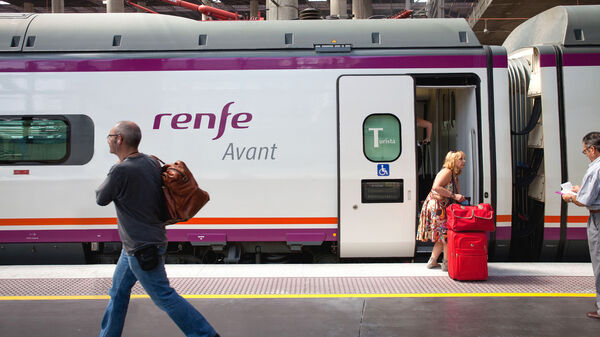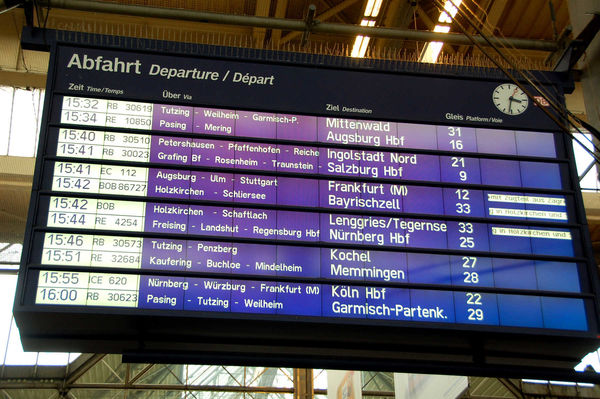Getting on the (Right) Train


By Rick Steves
For many Americans, Europe presents their first experience with a bustling train station, and the task of navigating the system and finding the right train can sound daunting. But anyone who's managed to find their way in a sprawling American airport will find Europe's train stations a snap. As you head for your train, ticket or pass in hand, keep these pointers in mind:
Get yourself to the right station. Many cities have more than one train station: Paris has six, Brussels has three, and even Switzerland's little Interlaken has two. Be sure you know whether your train is leaving from Interlaken East or Interlaken West, even if that means asking what might seem like a stupid question.
Find your track. A few countries publish track numbers in their train schedules, but in most places you'll need to look for your platform information once you get to the station. Upcoming departures are displayed on large boards; track information is usually posted about a half-hour before the train departs.
Ask for help. I always ask someone on the platform if the train is going where I think it is. Uniformed train personnel can answer any question you can communicate. Speak slowly, clearly, and with caveman simplicity. Resist the urge to ask, "Pardon me, would you be able to tell me if this train is going to Rome?" Just point to the train or track and say, "Roma?"
Be observant. If the loudspeaker comes on while you're waiting for your train at track 7, gauge by the reaction of those around you whether the announcement affects you. If, after the babble, everyone dashes over to track 15, assume your train is no longer leaving from track 7, and follow the pack.
Allow yourself sufficient time to navigate the station. Stations are generally laid out logically, with numbered tracks lined up in a row. But the biggest stations are so extensive they can take time to navigate. Some large stations have entirely separate sections for local and long-distance trains. For example, Madrid's Atocha station is divided into sections for cercanías (local trains) and AVE (high-speed, long-distance trains). A Paris train station might have some tracks devoted to Grandes Lignes ("grand lines" to other cities), and others for Transilien (local milk-run trains). At the Frankfurt airport, regional trains depart from the Regionalbahnhof, while long-distance trains use the Fernbahnhof. Many large stations also have vast sections devoted to subway trains or regional buses.
Be on guard for pickpockets. With travelers already distracted by announcements and luggage, a busy train station is an ideal work environment for thieves. Wear your money belt, keep your bags in hand, and be very wary of "helpful" locals hanging around ticket machines.
Where required, validate your ticket and/or seat reservation before boarding. In France and Italy, many point-to-point tickets and seat reservations printed on special ticket stock aren't valid until you've date-stamped them by inserting them into a machine near the platform (but if you've printed tickets at home, or have digital tickets, they don't need validating). If you have multiple parts to your ticket (for example, a ticket and a reservation), each one must be validated. Watch (or ask) others, and imitate — but don't assume that you can skip this step just because others have, as locals traveling with commuter passes won't be date-stamping them. (No matter where you're traveling, rail passes need to be activated before using them for the first time, and with a paper flexipass you need to have filled in your travel date before boarding the first train of the day.)
Expect no-hassle boarding. For the vast majority of Europe's trains, you stroll (or dash) right to your boarding platform, ticket or pass in hand, without any check-in formalities. The main exception is the Eurostar, which has check-in deadlines (30–45 minutes before departure) and an airline-style security procedure. You may encounter preboarding security or ticket checks in a few other places. In Spain, for instance, your tickets will be checked and luggage scanned before you access the platform to board fast AVE trains. Many stations in Britain require you to slide your paper ticket or tap your barcode on a turnstile reader both to enter and exit the boarding areas (if you're traveling with a rail pass, just show it to the attendants at these gates), and train doors close 30 seconds before departure. The Netherlands' chipkaart tickets must also be tapped on the card reader both when entering and exiting the station. And big-city stations in France and Italy are the latest to build barriers to restrict non-ticketholders from the platform area. Across Europe, some night trains have conductors checking tickets at the doors to each car.
Scope out the train ahead of time. The configuration of many major trains is charted in display cases on the platform. As you wait, study the display to note where the first-class, second-class, restaurant, and sleeping cars are, and which cars are going where. First-class cars are always marked with a big "1" on the outside, second-class cars with a "2." Some train schedules will say, in the fine print, "Munich-bound cars in the front, Vienna-bound cars in the rear." Knowing which cars you're eligible for can be especially handy if you'll be competing with a mob for a seat. When expecting a real scramble, I stand on a bench at the far end of the track and study each car as the train rolls by, looking in the windows to note where the empty places are. If there are several departures within an hour and the first train looks hopeless, I'll wait for the next. (If your train's at the start of its run, it may already be waiting at the platform, in which case you can open the door and board early.)
Never assume the entire train is going where you are. For long hauls, each car is labeled separately, because cars are usually added and dropped here and there along the journey. I'll never forget one hot afternoon in the center of Spain. My train stopped in the middle of nowhere. There was some mechanical rattling. Then the train pulled away leaving me alone in my car — in La Mancha. Ten minutes later, another train came along, picked up my car, and I was on my way. To survive all this juggling without any panic, be sure that the city on your car's nameplate is your destination. The nameplate lists the final stop and some (but not all) of the stops in between.

